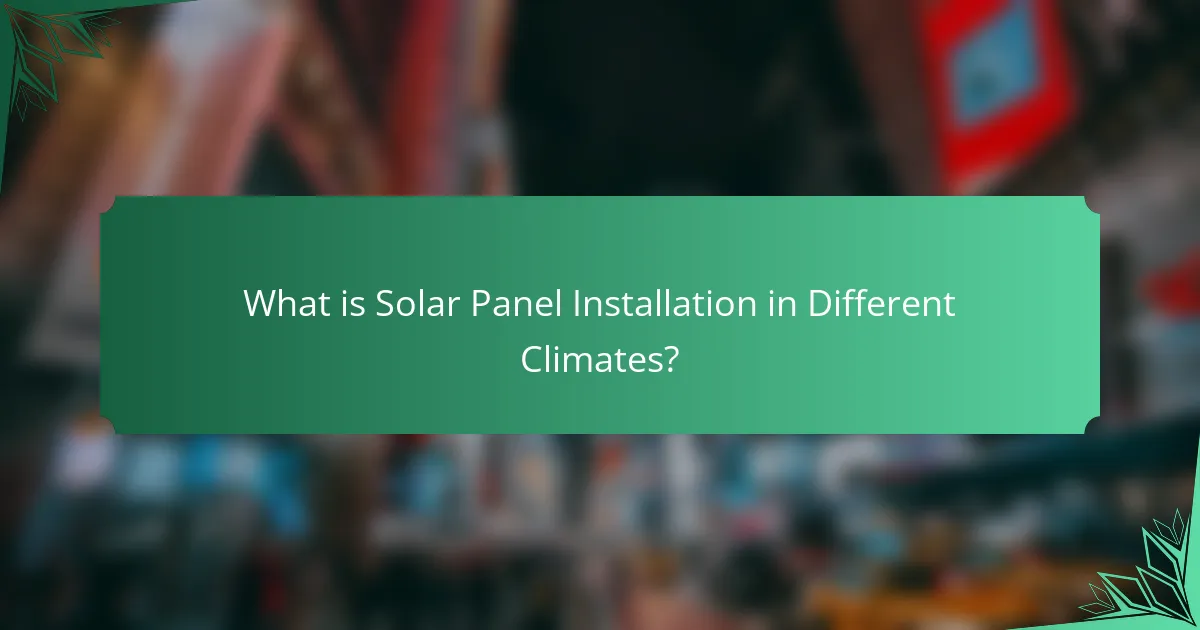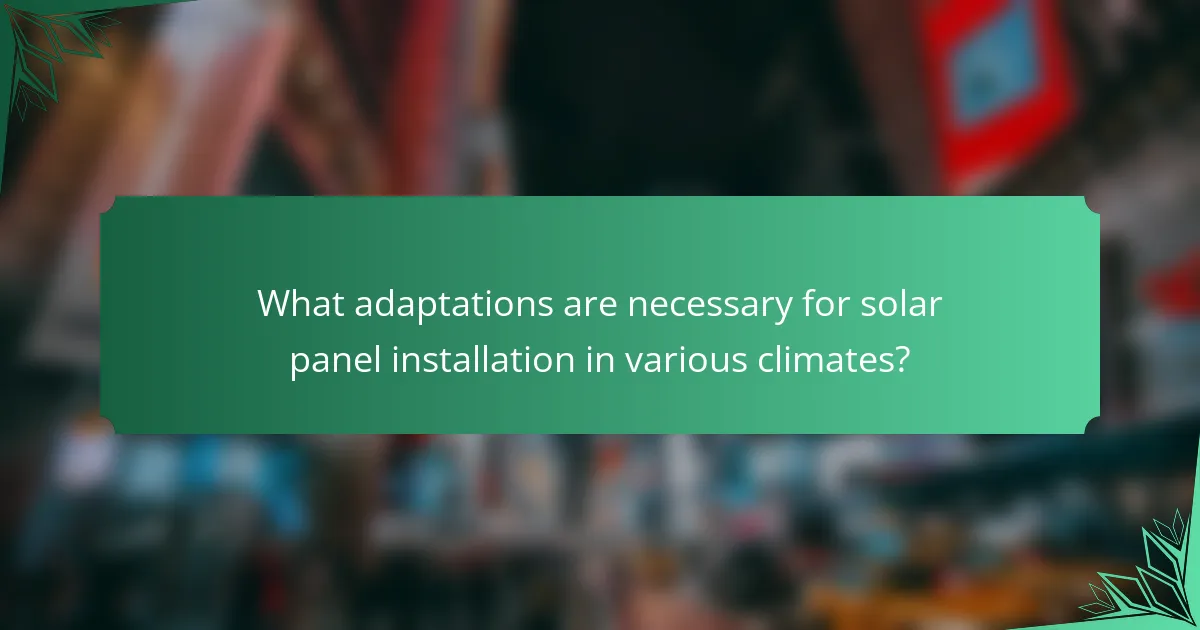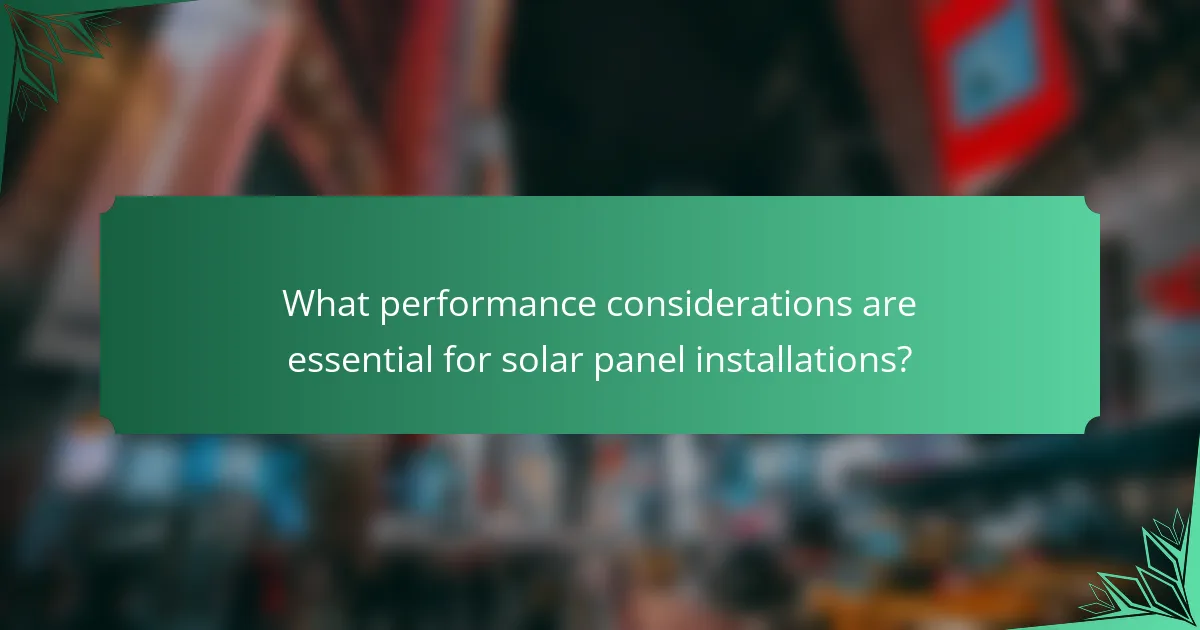
What is Solar Panel Installation in Different Climates?
Solar panel installation varies significantly across different climates. In sunny climates, installations maximize energy production due to high solar irradiance. In contrast, cold climates can also be effective, as solar panels operate more efficiently at lower temperatures. Humid and tropical regions require special considerations for moisture resistance and ventilation. In snowy areas, panels need to be installed at an angle to prevent snow accumulation. Windy climates necessitate robust mounting systems to withstand strong gusts. Each climate demands specific adaptations to optimize performance and longevity. Research shows that tailoring installation practices to local conditions enhances energy yield and system durability.
How do climate conditions affect solar panel installation?
Climate conditions significantly influence solar panel installation. Temperature extremes can affect the efficiency of solar panels. High temperatures can reduce panel output by causing overheating. Cold climates can impact the installation process and material durability. Snow accumulation may obstruct sunlight, necessitating specific mounting systems. Humidity and precipitation levels can also affect panel performance and longevity. Areas with high winds require robust mounting solutions to withstand potential damage. These factors must be considered during the design and installation phases to ensure optimal performance.
What are the key climate factors influencing solar panel performance?
The key climate factors influencing solar panel performance include temperature, sunlight intensity, humidity, and precipitation. High temperatures can reduce the efficiency of solar panels. For example, solar panel efficiency typically decreases by 0.5% for every degree Celsius above 25°C. Sunlight intensity is crucial, as panels generate more electricity with increased direct sunlight. Locations with consistent, high sunlight yield better performance. Humidity can affect the performance by causing condensation on panels, potentially reducing output. Precipitation, while generally beneficial for cleaning panels, can also lead to shading if panels are not optimally positioned.
How does temperature variation impact solar panel efficiency?
Temperature variation significantly impacts solar panel efficiency. As temperatures rise, the efficiency of solar panels typically decreases. Standard silicon-based solar panels operate optimally at cooler temperatures. For every degree Celsius increase in temperature, efficiency can drop by approximately 0.5% to 0.7%. Conversely, cooler temperatures can enhance performance.
High temperatures can lead to increased electrical resistance within the panels. This resistance reduces the amount of electricity generated. Additionally, overheating can cause long-term damage to the solar cells.
Research indicates that solar panels perform best between 15°C to 25°C. Outside this range, efficiency declines. For example, a study by the National Renewable Energy Laboratory found that panels in hotter climates can underperform by up to 20%.
Thus, temperature variation is a critical factor in solar panel performance and efficiency.
What are the different types of climates where solar panels can be installed?
Solar panels can be installed in various climates, including tropical, arid, temperate, and polar regions. Tropical climates offer high solar irradiance year-round. Arid climates often have minimal cloud cover, maximizing solar energy capture. Temperate climates provide moderate solar potential with seasonal variations. Polar climates can utilize solar panels during summer months despite lower overall energy production. Each climate type may require specific adaptations for optimal performance, such as tilt angle adjustments or temperature-resistant materials.
How do solar installations differ in tropical climates?
Solar installations in tropical climates differ primarily due to environmental factors. High humidity and frequent rainfall can affect the durability of solar panels. Tropical climates often experience intense sunlight, which can enhance solar energy production. However, the risk of overheating requires specific cooling solutions for optimal performance.
Additionally, tropical regions may face challenges from storms and hurricanes. This necessitates stronger mounting systems to withstand high winds. The presence of tropical vegetation also impacts installation, as shading from trees can reduce efficiency. Therefore, careful site selection is crucial for maximizing energy capture.
Overall, solar installations in tropical climates demand adaptations to manage moisture, heat, and potential storm damage effectively.
What challenges arise in installing solar panels in cold climates?
Installing solar panels in cold climates presents several challenges. Snow accumulation can obstruct sunlight, reducing energy production. Icy conditions can complicate installation logistics and increase safety risks for workers. Cold temperatures can also affect the efficiency of solar panel materials, such as reducing the conductivity of electrical components. Moreover, the ground may be frozen, making it difficult to secure mounting systems. These factors can lead to increased costs and extended installation timelines.

What adaptations are necessary for solar panel installation in various climates?
Solar panel installation requires specific adaptations based on climate conditions. In hot climates, panels should be installed with proper ventilation to reduce overheating. This can enhance efficiency by maintaining optimal operating temperatures. In cold climates, panels may need to be mounted at a steeper angle to facilitate snow shedding. This prevents accumulation that can block sunlight. In humid or tropical climates, corrosion-resistant materials are essential to withstand moisture and salt exposure. This helps to prolong the lifespan of the panels. Furthermore, in areas prone to high winds, securing panels with reinforced mounting systems is crucial. This prevents damage during storms. Each adaptation ensures that solar panels operate efficiently and reliably across diverse environmental conditions.
How can solar panel technology be adapted for extreme weather conditions?
Solar panel technology can be adapted for extreme weather conditions through several engineering and design modifications. These adaptations include using tempered glass for improved durability against hail and debris. Additionally, panels can be designed with a higher wind resistance rating to withstand strong winds.
Thermal management systems can be integrated to prevent overheating during extreme heat conditions. In snowy regions, solar panels can be installed with a tilt to facilitate snow shedding. Advanced mounting systems can enhance stability in areas prone to flooding or heavy rainfall.
Furthermore, materials with better corrosion resistance can be used in coastal areas with high salt exposure. Research indicates that these adaptations can significantly increase the lifespan and efficiency of solar panels in harsh environments.
What materials are best suited for high humidity environments?
Materials best suited for high humidity environments include stainless steel, aluminum, and certain types of plastics. Stainless steel is resistant to corrosion, making it ideal for humid conditions. Aluminum also resists corrosion and is lightweight, which is beneficial for solar panel installations. UV-resistant plastics, such as polycarbonate, withstand moisture without degrading. These materials maintain structural integrity and performance in high humidity. Research shows that corrosion-resistant materials extend the lifespan of installations in humid climates.
How can solar panels be designed to withstand heavy snowfall?
Solar panels can be designed to withstand heavy snowfall by utilizing robust materials and structural engineering. Manufacturers often use tempered glass for the surface, which is more resilient to impact. The frame of the solar panel is typically made from aluminum, providing strength and durability.
Additionally, panels can be installed at a tilt to facilitate snow shedding. This angle allows snow to slide off more easily rather than accumulating. Some designs incorporate heating elements to melt snow, ensuring consistent performance.
Testing standards, such as those from the International Electrotechnical Commission (IEC), assess the load-bearing capacity of solar panels under snow loads. For example, panels are often rated to withstand loads of up to 5400 Pa, equivalent to significant snow accumulation. These design features ensure that solar panels maintain functionality and longevity in snowy conditions.
What installation techniques are recommended for different climates?
Solar panel installation techniques vary based on climate conditions. In hot climates, it is recommended to use elevated mounts to enhance airflow and reduce overheating. This approach prevents efficiency loss due to high temperatures. In snowy regions, a steeper tilt is beneficial. It allows snow to slide off more easily, preventing accumulation that could block sunlight. For areas with high winds, using sturdy mounting systems is crucial. These systems should be anchored deeply to withstand strong gusts. In humid climates, corrosion-resistant materials should be utilized to ensure longevity. Proper sealing and drainage are also essential to prevent moisture damage. Each technique aligns with climate-specific challenges to maximize solar panel efficiency.
How does the angle of installation vary by region?
The angle of solar panel installation varies significantly by region due to differences in latitude and climate. In regions closer to the equator, such as tropical areas, solar panels are typically installed at a lower angle. This allows for maximum sunlight exposure throughout the year. Conversely, in higher latitude regions, such as northern Europe or Canada, solar panels are installed at a steeper angle. This adaptation helps capture more sunlight during the winter months when the sun is lower in the sky.
Research indicates that optimizing the angle can increase solar energy capture by up to 30% in certain regions. For instance, the optimal tilt angle in the United States varies from about 15 degrees in southern states to 40 degrees in northern states. These adjustments are made to enhance efficiency based on seasonal sun paths and local weather conditions.
What mounting systems are most effective in windy areas?
Ballasted mounting systems are most effective in windy areas. These systems use weight to secure solar panels, reducing the risk of lift-off during high winds. They distribute the load evenly across the surface, enhancing stability. Additionally, low-profile designs minimize wind resistance. Tilted mounts with adjustable angles can also help reduce wind load. Research indicates that ballasted systems can withstand wind speeds exceeding 100 mph when properly designed. Structural integrity is crucial; thus, materials used must be robust and corrosion-resistant.

What performance considerations are essential for solar panel installations?
Performance considerations for solar panel installations include efficiency, orientation, shading, temperature, and maintenance. Efficiency indicates how well solar panels convert sunlight into electricity. Optimal orientation maximizes sunlight exposure, typically facing south in the Northern Hemisphere. Shading from trees or buildings can significantly reduce energy output. Temperature affects performance; solar panels generally operate less efficiently at higher temperatures. Regular maintenance ensures panels remain clean and functional, which is crucial for optimal performance. Studies show that proper installation and attention to these factors can increase energy production by up to 30%.
How does shading impact solar panel performance in different climates?
Shading significantly reduces solar panel performance across all climates. When panels are shaded, their ability to convert sunlight into electricity diminishes. In temperate climates, partial shading can lead to a drop in energy output by 20% to 50%. In tropical regions, heavy shading can cause even greater losses due to higher humidity and cloud cover.
Moreover, the effects of shading vary with the time of day and season. In winter, low sun angles can increase shading issues. In contrast, summer months may experience more direct sunlight despite shading.
Research indicates that shaded panels can also lead to hot spots, potentially damaging the panels. A study by the National Renewable Energy Laboratory shows that even a small amount of shading can significantly impact energy yield. Thus, understanding shading effects is crucial for optimizing solar panel performance in any climate.
What strategies can mitigate shading effects on solar panels?
To mitigate shading effects on solar panels, one effective strategy is to optimize the placement and orientation of the panels. Properly positioning solar panels to avoid obstacles that cause shade can significantly enhance their efficiency. Additionally, using microinverters or power optimizers can help maximize energy output from shaded panels. These devices allow each panel to operate independently, reducing the impact of shading on overall system performance. Regular maintenance, including trimming nearby vegetation, can also prevent shading as plants grow. Installing solar panels on adjustable mounts can enable users to change angles seasonally, optimizing sunlight exposure. Implementing these strategies can lead to improved energy production and system longevity.
How do seasonal changes affect solar energy production?
Seasonal changes significantly affect solar energy production. During summer, longer days and higher sun angles increase solar energy generation. Conversely, winter brings shorter days and lower sun angles, reducing energy output. Cloud cover and precipitation also vary seasonally, impacting sunlight availability. For instance, solar panels can produce less energy during overcast days in winter compared to clear summer days. Studies indicate that solar energy production can drop by 30% or more in winter months in some regions. Therefore, understanding seasonal variations is crucial for optimizing solar panel performance.
What maintenance practices are important for solar panels in various climates?
Regular cleaning is essential for solar panels in all climates. Dust, dirt, and debris can accumulate on the panels, reducing their efficiency. In arid regions, cleaning may be needed more frequently due to higher dust levels. In humid climates, algae and mold can grow, necessitating regular inspections and cleaning.
Inspecting for damage is crucial regardless of climate. Hail or heavy winds can cause physical damage to panels. Regular checks help identify issues early, preventing costly repairs.
Monitoring system performance is important. Keeping track of energy output ensures panels are functioning optimally. A significant drop in output may indicate a need for maintenance.
In snowy climates, removing snow buildup is necessary. Snow can block sunlight and reduce energy production. Use a soft broom to avoid damaging the panels when clearing snow.
In coastal areas, corrosion can be a concern. Salt from the ocean air can affect panel frames and mounts. Using corrosion-resistant materials can mitigate this risk.
Overall, tailored maintenance practices based on climate conditions enhance the durability and efficiency of solar panels.
How can regular maintenance improve solar panel longevity?
Regular maintenance can significantly improve solar panel longevity by ensuring optimal performance and preventing damage. Routine cleaning removes dirt and debris that can block sunlight. This allows the panels to operate at maximum efficiency. Regular inspections identify potential issues like cracks or loose connections early. Addressing these problems promptly prevents more severe damage over time. Additionally, maintaining the electrical components reduces the risk of failures. Studies show that well-maintained solar panels can last 25 years or more. In contrast, neglected panels may experience reduced lifespan and efficiency. Therefore, consistent maintenance is crucial for maximizing solar panel durability and effectiveness.
What specific maintenance challenges are faced in desert climates?
Desert climates present unique maintenance challenges for solar panel installations. High temperatures can lead to overheating, which reduces efficiency and lifespan. Dust accumulation on panels is common due to arid conditions, requiring frequent cleaning to maintain optimal performance. Additionally, intense sunlight can cause thermal expansion and contraction, potentially damaging the panel materials over time. Limited water resources make cleaning difficult, complicating maintenance efforts. These factors necessitate specialized maintenance strategies tailored for desert environments.
What are the best practices for optimizing solar panel performance in diverse climates?
To optimize solar panel performance in diverse climates, select appropriate panel types. Monocrystalline panels perform well in low light conditions. Polycrystalline panels are cost-effective but less efficient in high heat. Install panels at an optimal angle for maximum sunlight exposure. This angle varies with latitude and season. Regular cleaning of panels enhances performance by removing dirt and debris. In snowy climates, a tilt can help snow slide off, improving energy generation. Use microinverters or power optimizers for better performance in shaded areas. These technologies maximize output by managing the performance of individual panels. Monitoring systems can track performance and identify issues promptly.
How can homeowners maximize energy output from their solar systems?
Homeowners can maximize energy output from their solar systems by optimizing panel placement and angle. Proper orientation towards the sun increases exposure and efficiency. Keeping solar panels clean enhances light absorption. Regular maintenance ensures optimal performance and longevity. Homeowners should also consider energy storage solutions to utilize generated power effectively. Monitoring energy production helps identify inefficiencies. Upgrading to high-efficiency panels can yield better output. These strategies collectively improve solar system performance and energy generation.
What common troubleshooting tips should be considered for solar panel systems?
Check for dirt or debris on solar panels. Cleaning them can improve efficiency. Inspect all wiring and connections for damage. Loose or frayed wires can cause performance issues. Ensure the inverter is functioning properly. A faulty inverter can affect energy conversion. Monitor the system’s output regularly. This helps identify any drops in performance. Review the shading around the panels. Trees or buildings can block sunlight. Check the orientation and tilt of the panels. Proper angles maximize sun exposure.
Solar panel installation involves adapting techniques and materials to optimize performance across various climates. This article examines how climate factors such as temperature, humidity, and precipitation influence solar panel efficiency and installation practices. It details the necessary adaptations for different environments, including strategies for managing snow, heat, and wind. Additionally, the article highlights maintenance practices essential for prolonging the lifespan and effectiveness of solar panels in diverse conditions. By understanding these elements, homeowners and installers can enhance energy production and ensure system durability.